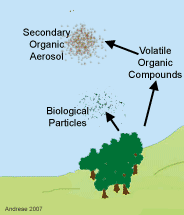Atmospheric fine particle mass mostly originates from emissions from motor vehicles, wildfires and other combustion processes. When emissions are exposed to oxidants and sunlight, they evolve chemically and physically to generate secondary particulate matter. Dr. Allen L. Robinson, Head of the Department of Mechanical Engineering at Carnegie Mellon University, shared results from their investigations of atmospheric evolution of emissions at the SOCAAR Seminar on February 1, 2017. Continue reading
Tag Archives: aerosol particles
Sources of Fossil Fuel and Biomass Burning Black Carbon in Ontario

Source: Toronto Star
Black carbon (BC) particles are generated through incomplete combustion processes including combustion of fossil fuels and biomass. These two sources are most commonly from vehicles and residential wood burning for heating. BC has an overall warming effect on the global climate and long-term exposure to it has been associated with cardiopulmonary mortality.
Dr. Robert Healy, Senior Environmental Officer at The Ontario Ministry of the Environment and Climate Change, spoke about the Ministry’s work on assessing the sources of fossil fuel and biomass burning black carbon in Ontario at the SOCAAR Seminar on November 30th, 2016. Continue reading
Bridging cloud condensation nuclei activity and volatility of oxidized organic aerosol
In SOCAAR seminar held on April 6th Dr. Shunsuke Nakao, Assistant Professor at Clarkson University presented a theoretical framework used to study the aging of atmospheric organic aerosol.
Organic aerosol change (i.e. oxidize) as they age in the atmosphere and are nuclei for cloud formation. Having an understanding of the change in cloud condensation nuclei (CCN) activity of organic aerosol as they evolve overtime can be used to identify the impact of organic aerosol on the climate. Continue reading
Measurements and Modeling of Ultrafine Particulate Matter in California
Toxicological studies have consistently found that ultrafine particles are potentially harmful. Yet only recent epidemiological studies have been able to link ultrafine particles to negative public health effects. The difficulty in finding effects in epidemiological studies may be in part because of the population exposure metrics used in previous studies. In the December 2 SOCAAR Seminar Dr. Michael J. Kleeman, a professor at UC Davis’ Department of Civil and Environmental Engineering, presented 15 years of research on the measurements and modeling of ultrafine particular matter in California. Continue reading
Exploring the connections between aerosols and clouds in the high Arctic summer

Photo credit: Julia Burkart
It’s well known that the Arctic climate is influenced by anthropogenic contributions like heating during the winter and regional sources in the summer. But the chemistry of the aerosol environment and its influence on the cloud formation over the Arctic is less understood. Dr. Julia Burkart and Megan Willis, a postdoctoral fellow and Ph.D. student respectively, at the University of Toronto’s Department of Chemistry presented findings from their NETCARE summer aircraft campaign in Resolute Bay, Nunavut at the SOCAAR Seminar held on November 5. Continue reading
Near-road measurement of traffic-related pollutants

Photo Source: Wikipedia user Aliamizi
Traffic related pollutants were officially classified as carcinogenic by the World Health Organization in 2013. For the many Canadians that live or work near roadways, this could be a risk factor which may negatively impact their health.
Dr. Cheol-Heon Jeong and Jon Wang, both of UofT’s Department of Chemical Engineering and Applied Chemistry, say the concentration of traffic-related pollutants varies with distance from the road; where significant pollution can be detected up to 250 metres from the road. Continue reading
Characterization of atmospheric black carbon in Toronto and the oil sands region
Human activities like burning fossil fuels and vehicle emissions generate of variety of aerosol particles like black carbon, organic, sulphate, and nitrate particles. The interaction between black carbon and other aerosol particles can change the physical and chemical properties, such as light absorption of black carbon particles. Understanding the chemical nature of these aerosol particles is important in evaluating their environmental impacts. Continue reading
Real-time characterization of soot particles
Soot particles are seen everywhere from city centres to the Alps. There’s ongoing debate on the nature and dynamic evolution of these particles in atmosphere. Soot are light-absorbing, chemically and morphologically complex particles that contribute to air pollution and can have negative health effects. Soot particles are emitted from flames and engines and are highly regional pollutants. Continue reading
Observations and impacts of aerosol acidity in North America
It’s not just the presence of aerosols but also the characteristics of the particles emissions that are related to air quality. Aerosol acidity can also have an impact in terms of human and ecosystem health. In the latest SOCAAR seminar, Dr. Jennifer Murphy, an associate professor in UofT’s Department of Chemistry, discussed the changes in the aerosol acidity from geographically diverse sites across North America.
Oil sands can produce sulphur emissions which contribute to the acidity in the atmosphere. Particle acidity is the amount of acid found in the particle phase. The deposition of acid containing particles can lead to the acidification of an ecosystem because the acidity of particles can affect the hydrophobicity of water and have climate impacts. Also, such particle absorption may influence human health.
Looking the aerosol acidity research conducting between 1990 and 2010, Murphy observes decreases in the particle emissions at various industrial, remote, and marine sites investigated in these studies. More importantly all of these sites also show significant decrease in strong acidity. She believes that this trend is likely true for the particle pH as well. Her team is currently carrying out calculations to confirm that this is the case. This trend could suggest that the gas particle partitioning behaviour and/or the particle chemistry itself is changing.
The next step of Murphy’s research will be to extend the analysis beyond just continental surface aerosol but also to aircraft field campaigns and other locations. These future studies will help determine how these values can change in different environments.
HVAC filters used to investigate indoor airborne particle exposure
We spend about 90 per cent of our time indoors and airborne particles are one of the greatest indoor health risks. Research studies have shown that the majority of particles that are breathed indoors come from fine particulate matter (PM2.5). But before the air quality in residential and commercial buildings can be fully assessed, we need to first understand the composition and amount of indoor particles.
Jeffrey Siegel, an associate professor in the University of Toronto’s Department of Civil Engineering, has been investigating the use of heating, ventilation, and air conditioning (HVAC) filters as a new sampling method to detect airborne particles. In this SOCAAR seminar Siegel discusses what we can learn about human exposure to indoor contaminants from HVAC filters. Continue reading


